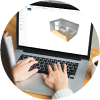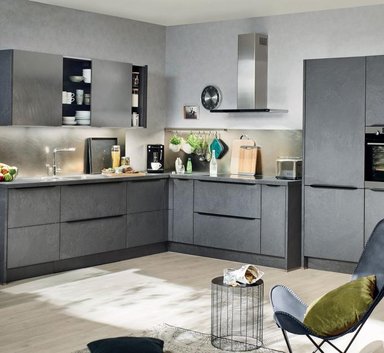
Functional: an essential two-in-one
Originally, the term “splashback” referred to the section of wall above a sink or cooker that protects the paint from water or grease. Nowadays, in modern fitted kitchens, it often refers to the space all along the wall between the worktop and wall units, made from a material that is both aesthetically pleasing and easy to clean. This splashback serves a dual purpose, protecting the wall from splashes and stains while adding a decorative touch to your kitchen. The cooker-hood splashback is a more specific version, fixed behind the hob. Its material should be able to withstand high heat and moisture (e.g. stainless steel or glass) and be easy to clean, as it is exposed to the toughest stains, such as grease. It should be the same width as the cooker hood and placed at least 10cm from your hob.

On-trend: the splashback makes a splash
A splashback can be a useful design addition to your kitchen. Available in a wide range of materials, colours, patterns and textures, they can provide valuable creative support. They can add a decorative touch to your kitchen, showcasing its uniqueness. That is certainly true of bespoke splashbacks, decorated with an artistic design or a personal photo, which will prove a vibrant addition to a simple and traditional kitchen. It is also true of the very fashionable slate splashbacks, where you can jot down your shopping list – a fun and practical option.
Your splashback can also take the lead and impose its style. Cement or subway-style tiles and you’ll turn back time to a retro, vintage-style kitchen. Materials like copper, stainless steel or concrete – whether worked or plain – create a very modern urban and industrial loft-style. Looking for a touch of elegance? Opt for marble or natural stone! After a rustic look? Choose the charm of wood. Want something vibrant? Go for glass with colourful pop graphics. The choice is yours – simply go for the theme that suits you best.

Sturdy: three high-quality materials
Now, let’s get down to details: which covering should you choose? Faced with the array of possibilities, if you’re unsure where to start, we’ll provide you with guidance, starting with the three top materials in terms of durability and easy maintenance. These two criteria are of paramount importance given that the primary function of a splashback is to protect against water splashes, steam and grease splatters.

Tiles: a safe bet
Whether in mosaic, small tiles or large slabs, tiles have a retro, vintage look but have also been brought very up-to-date. They remain timeless thanks to their durability that withstands the years. They can handle high temperatures and impacts and are easy to clean with soapy water. This makes it the preferred material for splashbacks. The only downside is the grout, which can be difficult to clean over time. The only downside is the grout, which can be difficult to clean over time.

Glass: the low-maintenance option
Whether matt, shiny, transparent or lacquered, glass splashbacks can fit into any style, from reproduction of paintings and patterns, to photo prints or recessed lighting. It is especially popular because it is non-porous and perfectly hygienic. And cleaning it is a breeze – all it takes is a quick wipe and it’s clean.

Stainless steel: the ultimate choice for kitchens
For durability and hygiene, stainless steel is the ultimate choice. It can withstand water, corrosion and extreme temperatures. That is why it is often used as a splashback behind hobs. It is very hygienic as it reduces the growth of microbes, making it suitable for communal spaces. Finally, it is quick and easy to clean. Its easy installation makes the stainless steel splashback an economical and durable option – as long as it matches your kitchen’s style.

Practical: how to enhance its performance
The splashback is not only there to be beautiful and protective – it can also offer numerous practical benefits.
- With backlit glass panels using LEDs, it can be illuminated to brighten your worktop or hob. That’s very useful for seeing the lustrous colours of the vegetables you’re chopping or for monitoring your cooking.
- It can become an additional storage surface if you add shelves with aluminium rails or bars to hang utensils or a kitchen-roll holder.
If you choose a magnetic material for your splashback, you can magnetise it to hold knives or aluminium spice containers.
A mirrored-glass effect can enlarge your space and reflect more light. Thanks to its enhanced performance, the splashback is ready to make your life in the kitchen even more enjoyable.
















